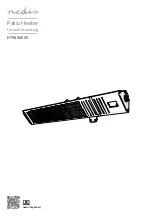
2
MFH-I&S-02
Make sure that you check the rating plate and combination gas control on the
water heater to be certain that the type of gas being supplied corresponds with
the marking on the rating plate and combination gas control.
A sacrificial anode is used to extend tank life. The removal of this anode, for
any reason, will nullify the warranty. In areas where water is unusually active,
an odor may occur at the hot water faucet due to a reaction between the
sacrificial anode and the impurities in the water. If this should happen, an
alternative anode may be purchased from the supplier that installed this water
heater. This will minimize the odor while protecting the tank. Additionally, the
water heater should be flushed with appropriate dissolvers to eliminate any
bacteria.
INSTALLATION
Locating The Water Heater
This water heater shall NOT be installed in any location where gasoline or
flammable vapors are likely to be present, unless the installation is such to
eliminate the probable ignition of gasoline or flammable vapors.
The location of this water heater is of the utmost importance. Before installing
this water heater, you should read the Installation section of these instructions.
DO
NOT
locate the water heater where water lines could be subjected to
freezing temperatures. Make sure the cold water pipes are not located directly
above the gas control so that condensate during humid weather does not drip
on the controls.
Water heater corrosion and component failure can be caused by the heating
and breakdown of airborne chemical vapors. Examples of some typical
compounds that are potentially corrosive are: spray can propellants, cleaning
solvents, refrigerator and air conditioning refrigerants, swimming pool chemicals,
calcium and sodium chloride, waxes and process chemicals. These materials
are corrosive at very low concentration levels with little or no odor to reveal
their presence.
NOTE: DAMAGE TO THE WATER HEATER CAUSED BY
EXPOSURE TO CORROSIVE VAPORS IS NOT COVERED BY THE
WARRANTY. DO NOT OPERATE THE WATER HEATER IF EXPOSURE
HAS OR WILL OCCUR. DO NOT STORE ANY POTENTIALLY
CORROSIVE COMPOUNDS IN THE VICINITY OF THE WATER HEATER.
For exact venting specifications, please consult the Venting section, located on
page 3, of these Installation and Operating Instructions.
This water heater must be located in an area where leakage of the tank, water
line connections, or the combination temperature and pressure relief valve will
not result in damage to the area adjacent to the water heater or to lower floors
of the structure. When such locations cannot be avoided, a suitable drain pan
must be installed under the water heater. The drain pan must be no greater
than 1-½ inches
(3.8 cm)
deep and have a minimum length and width of at
least 4 inches
(10.2 cm)
measured from the jacket of the water heater. The
drain pan, as described above, can be purchased from your plumbing
professional. The drain pan must be piped to an adequate drain. The piping
must be at least 3/4 inch
(1.9 cm)
in diameter and pitched for proper
drainage.
It is recommended that a minimum clearance of 4 inches
(10.2 cm)
be
provided on the side of the water heater for servicing and maintenance of the
combination temperature and pressure relief valve.
MINIMUM CLEARANCES
This installation shall allow access to the front of the water heater and adequate
clearance shall be provided for servicing and operating this water heater. The
water heater may be installed on either a combustible or non-combustible
floor. If the water heater is to be installed directly on carpeting, it shall be
installed on top of a metal or wood panel (or equivalent) extending beyond
the full width and depth of the appliance by at least 3 inches
(7.6 cm)
in any
direction or, if the appliance is to be installed in an alcove or closet, the entire
floor shall be covered by the panel.
WARNING
Liquefied petroleum gases/propane gas are heavier than air and will remain at floor
level if there is a leak. Basements, crawl spaces, closets and areas below ground level
will serve as pockets for accumulation of leaking gas. Before lighting, smell all around
the appliance area for gas. Be sure to smell next to the floor.
WARNING
Failure to adhere to these installation and operating instructions
may create a hazard to life and property and will nullify the
warranty.
WARNING
Water heaters are heat producing appliances. To avoid damage or injury there shall
be no materials stored against the water heater or vent-air intake system and
proper care shall be taken to avoid unnecessary contact (especially by children) with
the water heater and vent-air intake components.
UNDER NO CIRCUMSTANCES
SHALL FLAMMABLE MATERIALS, SUCH AS GASOLINE OR PAINT THIN-
NER BE USED OR STORED IN THE VICINITY OF THIS WATER HEATER,
VENT-AIR INTAKE SYSTEM OR IN ANY LOCATION FROM WHICH FUMES
COULD REACH THE WATER HEATER OR VENT-AIR INTAKE SYSTEM.
WARNING
DO NOT ATTEMPT TO LIGHT ANY GAS APPLIANCE IF YOU ARE
NOT CERTAIN OF THE FOLLOWING:
• Liquefied petroleum gases/propane gas and natural gas have an
odorant added by the gas supplier that aids in detection of the gas.
• Most people recognize this odor as a “sulfur” or “rotten egg” smell.
• Other conditions, such as “odorant fade” can cause the odorant to
diminish in intensity, or “fade”, and not be as readily detectable.
• If you have a diminished sense of smell, or are in any way unsure of
the presence of gas, immediately contact your gas supplier from a
neighbor’s telephone.
• Gas detectors are available. Contact your gas supplier or plumbing
professional for more information.
WHAT TO DO IF YOU SMELL GAS
• Do not try to light any appliance.
• Do not touch any electrical switch; do not use any
telephone in your building.
• Immediately call your gas supplier from a neighbor’s
telephone. Follow the gas supplier’s instructions.
• If you cannot reach your gas supplier, call the fire
department.


























